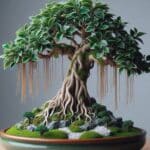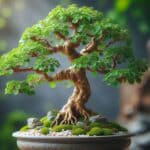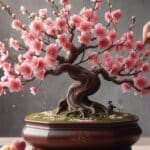Rosemary is prized for its aromatic qualities and its ability to make just about any recipe ten times more delicious. But did you know that you can also grow rosemary bonsai plants to add interest and appeal to your home?
Rosemary officinalis, a name that translates to “mist of the sea,” is a gorgeous plant with elegant green-gray foliage. It is native to the Mediterranean, meaning it needs to be kept in a warm climate if you plan on growing it outdoors year-round. However, if you’re willing to bring your rosemary plant indoors for the winter months, you can grow it as a bonsai plant in any environment.
In its natural habitat, rosemary blooms year-round, producing lovely blue flowers and growing in a shrub-like fashion with evergreen needles. It has fibrous bark, making the plant look highly unique and attractive even when it is relatively young. One of the most unique features of this plant is that it can be grown not only for its visual qualities as a bonsai – but also for its culinary abilities.
There are few requirements for care when it comes to nurturing a rosemary bonsai. Here are some tips on keeping this common herb bonsai plant healthy.
Interesting Facts about Rosemary Bonsai
| Height | 7-14” |
| Width | 7-10” |
| Sunlight | Full sunlight |
| Flowering Time Length | Late spring-early summer |
| Lifespan | 20 years |
| Scientific Name | Rosemary officinalis |
Growing Rosemary Bonsai from Seed or by Propagation
You can plant a bonsai rosemary from cuttings or by seed. Start your new plants with cuttings from existing plants for the quickest results, planting cut stems that are roughly two inches long. Remove any leaves before you plant, then place the cuttings in a mixture of peat moss and perlite. Spritz with water until the roots grow and you can then plant the cuttings just as you would a regular rosemary plant.
Rosemary Bonsai Care Guide
Sunlight
Rosemary bonsai plants thrive in full sunlight, requiring at least six to eight hours of direct sunlight each day to flourish.
Place the bonsai in a south-facing window or outdoors in a location where it receives ample sunlight. Insufficient light can result in leggy growth and sparse foliage, so it’s crucial to provide adequate exposure to sunlight. If growing indoors, supplement natural light with artificial grow lights to ensure the bonsai receives the necessary light intensity.
This proper sunlight exposure for rosemary bonsai puts the plant in a position to develop compact growth, dense foliage, and vibrant health.
Watering
Water rosemary plants deeply and thoroughly when irrigating, ensuring that the water reaches the root zone. During hot and dry periods, increase the frequency of watering to prevent the soil from becoming too dry.
Avoid overwatering, as rosemary is susceptible to root rot in waterlogged conditions. Additionally, mulching around the base of the plant can help retain soil moisture and regulate temperature, contributing to the overall health and vigor of the rosemary plant.
Fertilizing
Rosemary is not a voracious feeder. However, you are best off fertilizing your rosemary bonsai in the spring. A good option to use is a fish emulsion, which will give your plant a quick-absorbing dose of the nutrients it needs. You can also use a foliar spray on a regular basis.
Potting and Repotting
Potting and repotting are essential aspects of caring for a rosemary bonsai. When initially potting a rosemary bonsai, choose a well-draining potting mix, such as a blend of bonsai soil, perlite, and pine bark, to promote healthy root growth.
As with most potted plants, repotting should be done every two to three years to prevent the roots from becoming pot-bound and to refresh the soil. It’s best to repot in the spring before new growth begins.
Carefully remove the bonsai from the rosemary pot, prune any circling roots, and replant it in fresh soil, ensuring the roots are spread out evenly. This promotes continued growth and vitality in the rosemary bonsai.
Pruning Rosemary Bonsai
Rosemary plants require pruning regularly. One of the most exciting aspects of growing a rosemary bonsai is that you can put those trimmings to good use – in your cooking! Just snip sprigs whenever you’d like to use them in the kitchen, but don’t cut back more than a third of the plant at a time.
You can occasionally wire the branches to shape them as well. Only attempt to wire those that are smaller in diameter than that of half of a pencil.
Pests and Diseases
Rosemary bonsai plants are occasionally prone to powdery mildew when they are grown indoors. This white, powdery fungal disease typically arises when the air is humid and there is poor air circulation. Although it won’t’ usually kill your plant, it can severely weaken it. Make sure there is good circulation in the room in which you are growing your plant (you might add a fan, for instance).
Keep an eye out for pests like aphids and spider mites. You can spray leaves with diluted water and soap solution to get rid of them.
Where to Buy Rosemary Bonsai
Perfect to work with as a bonsai plant, a rosemary bonsai can be purchased anywhere you might buy a regular rosemary plant – you can also buy seeds and start your own plant. Since rosemary, at its very largest when grown outdoors, only grows to the size of a small shrub, it will grow rapidly from seed and can therefore mature quickly in a container.
This is an economical way to buy more rosemary plants – although you can of course always purchase a starter plant from a gardening store, nursery, or in some cases, even a grocery store, too.
FAQs
What soil do you use for rosemary bonsai?
For rosemary bonsai, use well-draining soil with a mix of coarse sand, perlite, and organic matter such as pine bark or compost. This helps mimic the rocky, well-drained soil conditions that rosemary prefers.
How do you take care of a small rosemary tree?
Care for a small rosemary tree by providing it with plenty of sunlight, watering it when the top inch of soil feels dry, and ensuring it has good air circulation. Prune it regularly to maintain its shape and size, and fertilize sparingly during the growing season.
How do you thicken rosemary trunks?
To thicken rosemary trunks, encourage healthy growth by providing optimal growing conditions such as plenty of sunlight, well-draining soil, and regular watering. Additionally, selective pruning can promote branching and trunk development.
How long does rosemary plant last?
Rosemary plants are perennial herbs that can last for several years when grown in the right conditions. With proper care, they can live for five to ten years or more, providing fresh herbs for culinary use.
How do you prune rosemary bonsai roots?
Prune rosemary bonsai roots by carefully removing the plant from its container, untangling the roots, and trimming away any circling or overly long roots. Trim no more than one-third of the root mass, repot the bonsai in fresh soil, and water thoroughly. Repeat root pruning every 1-2 years to maintain root health and prevent the bonsai from becoming root-bound.
Also check other bonsai trees you can grow here.
*image by Wirestock/depositphotos







